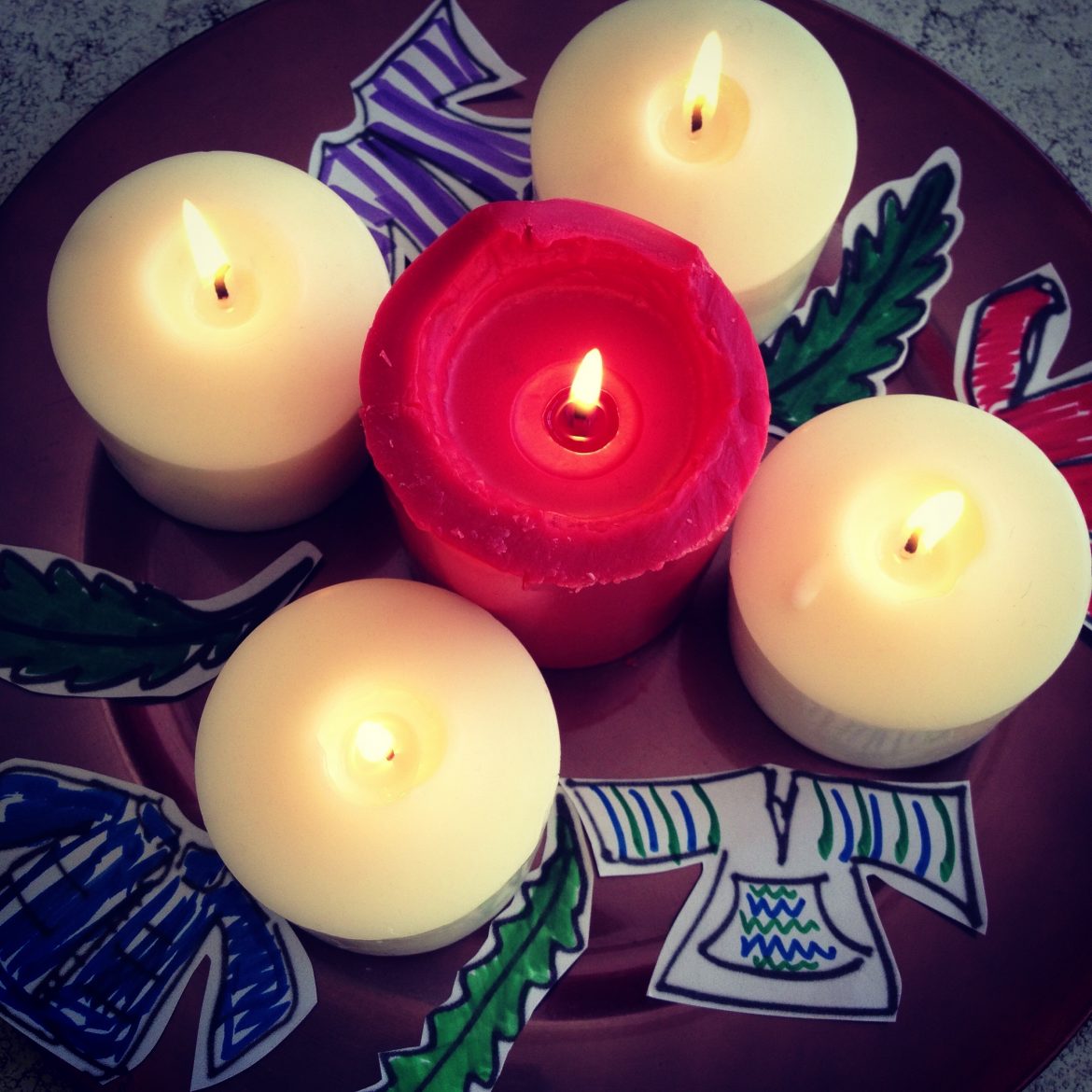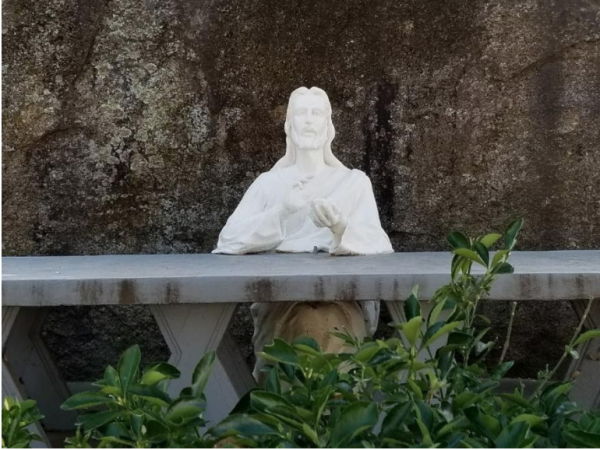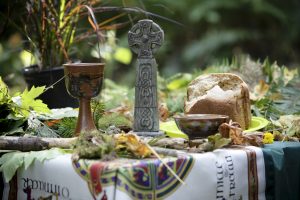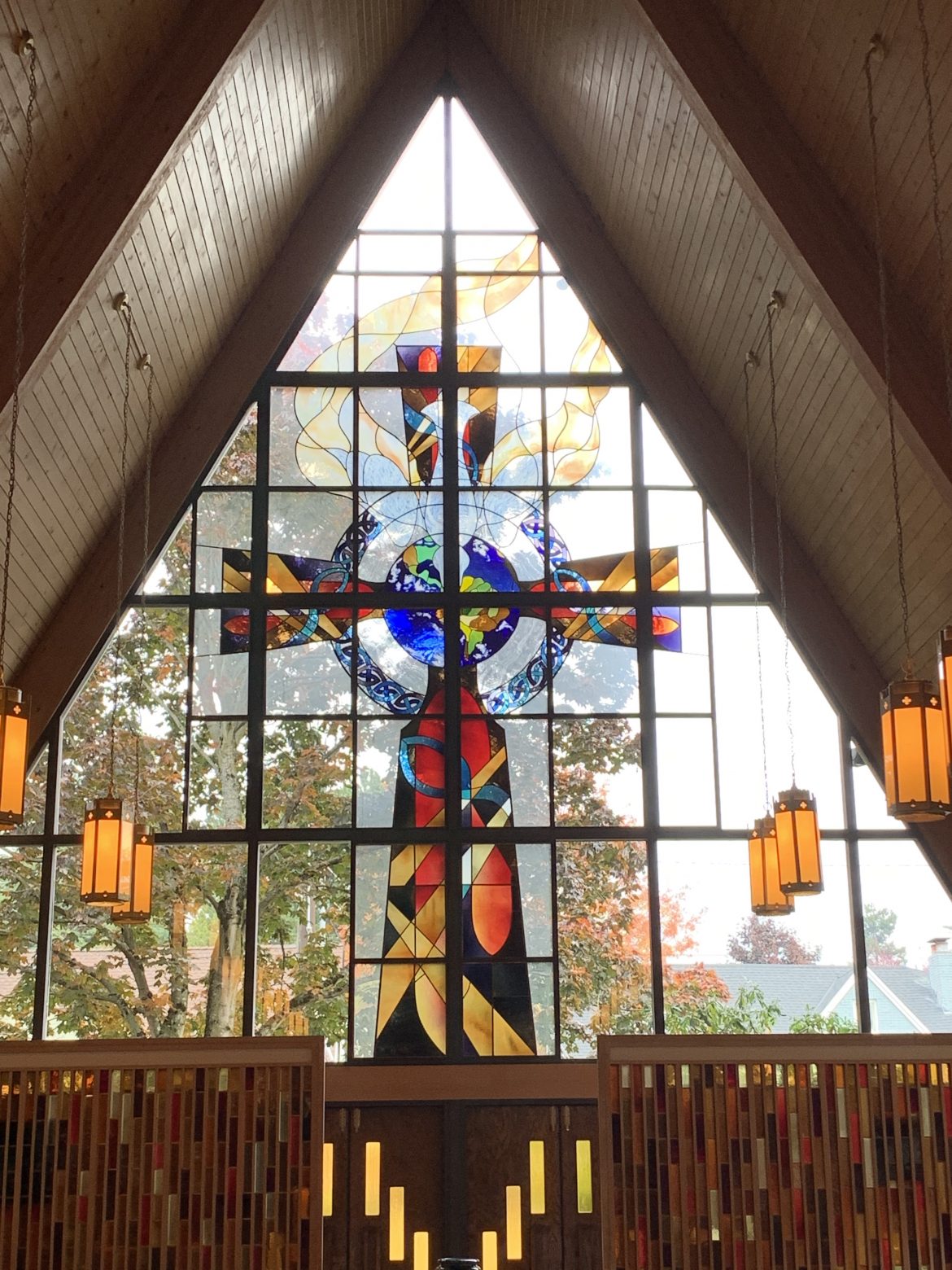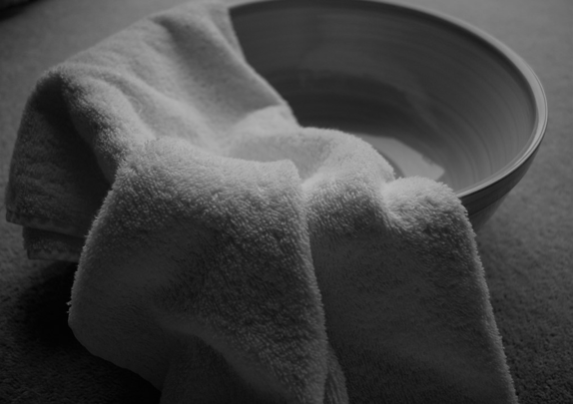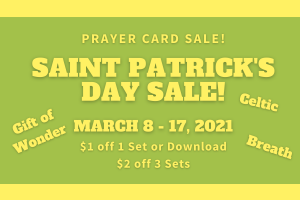By Lilly Lewin
I am re-posting this resource from last year so you will have time to gather your supplies to create a centerpiece on your own or with your family or flatmates/roommates. The PDF with all the details and the print outs is found at the end of the post. Even if your church community is meeting in person this year, this Holy Week Centerpiece is a great tangible way to remember the last week in the life of Jesus.
Several years ago, I created a Holy Spirit Centerpiece that retells the story of the last week in the life of Jesus. Since many of us are at home this Holy Week, I thought it would be great to share this again. The center piece is not as easy to do as Praying with your Cup for Holy Week, but it’s a powerful way to connect the story of Holy Week around your dining table or even your coffee table. You might even do this together as a community via Zoom or Facebook Live! The host would have all the supplies set up and would lead the prayers each day.
Holy Week Centerpiece2020 PDF is at the end of this post and you are free to share and print out, just please acknowledge my creativity and authorship. Thanks! I’d love to hear how you use it yourself or with your family. 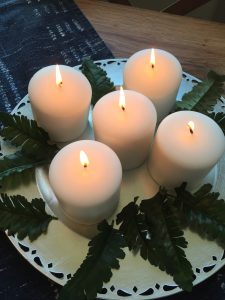
Holy Week Centerpiece Created by Lilly Lewin
Experiencing Holy Week by yourself, with family, kids, youth group etc, and even together on line!
In preparation for Holy Week, here is a centerpiece and meditation you can create for yourself, your family, or even online via a video or on a Zoom call with your community!
In the future, you could create this for your entire church community on site (making it larger as necessary…using larger candles and enough supplies for your entire group)
Each day there is an activity/response you can do on your own or with your family/group to retell the story of the last week of Jesus’s life.
The centerpiece works a bit like a reverse advent wreath. Start with all the candles lit on Palm Sunday and Monday, and then you extinguish a candle each day, and thus the centerpiece is dark on Saturday. And all candles are relit on Easter! Begin with a plate or dish for your centerpiece and 5 candles. I use a red candle for Good Friday and place it in the center, but you could also do the candles in a row if you were creating this on an altar space. This can also be created for your coffee table rather than your dining table.
Remember you don’t have to do all of this, just start. Do a couple of days. Do what works for you and your family/group. Feel free to modify the questions for the ages in your group.
We started with just the candles and purple cloth activity the first year. Get your family/group/roommates to join in the creation of the centerpiece and getting the props together. Just use what you have!
I love this way to pray, because we remember much more of what we do than what we hear. And I would love to hear how you use this centerpiece. Please email me!
Rejoicing in the already but not yet! Lilly ©lillylewin and freerangeworship.com
SUPPLIES:
• 5 Candles in a perfect world 4 white, 1 red
• Dish or plate that will hold candles and be large enough for extra things to be added to it.
• Pieces of fern or palm branches, size depends upon size of your table/centerpiece. I have a small table so we have a small centerpiece.
• Cut out clothes/jackets either from magazines or run off outlines like paper doll clothes on 8.5×11 sheets of paper. PDF included.
• Coins – pennies or the plastic gold coins
• Olive oil, vegetable oil or bottle of perfume
• Hershey kisses enough for everyone or Kiss Cut Out
• Pieces of paper with a plate drawn on it to use as placemat, or printout of place mats, enough for all members of your group.
• Purple Fabric (or any color) cut into 3×6 inch strips, make a half inch cut in the short end of each strip so they can easily be torn into two parts
• Piece of muslin or black cloth that will cover entire centerpiece to represent grave cloth.
• Band aids – one for each person.
• Candles – one for each person in your group (you can use small birthday candles) 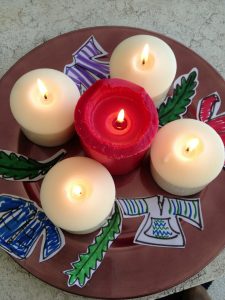
HOLY WEEK CENTERPIECE
DAY 1: Palm Sunday, (Palm cut and coat cut outs, or pieces of fern)
Pick a passage Matthew 21: 1-10, Luke 19: 28-40, Mark 11: 1-11,John 12:12-19. LIGHT ALL 5 candles.
Read the story of Jesus entering Jerusalem, and talk about what it would be like to be in the crowd when Jesus rode into town. What do you see, hear, smell? Are you excited, scared, angry like the Pharisees? Talk about this.
Add pieces of palm fronds or cuts of a fern to symbolize the entry into Jerusalem. If you have younger kids in your group or you are feeling artistic, print off the page of coats, jackets and palm branches and color these and cut them out and place around the centerpiece plate .
DAY 2: Monday: Cleansing the Temple (dish of pennies/coins)
Leave Palm Branches around the plate for a couple of days and bring a bowl of pennies/coins to the table.
Read the story: Luke 19:45-48, Matt. 21:12-17, Romans 8:35-39
LIGHT ALL THE CANDLES and have someone blow out one of them.
Pass around the coins and HOLD A penny/coin in your hand and think about the scene. What does it look like, smell like, what do you see? What do you notice?
The Money Changers were blocking people’s access to prayer & worship, especially the Gentiles.
What things block you from prayer and worship right now?
What things keep you from worshipping Jesus?
What things (like the tables of the money changers) keep you from being with God?
News, Texting, Computer time, facebook, Netflix Video games, busyness, fear, worry, lack of trust, what else?
As you hold your coin, TALK to God about these things. Allow Jesus to hold these things for you and ask Jesus to take away these blocks.
Then take time to talk about this as a group if you are with others.
DAY 3: Tuesday: Anointing at Bethany (olive oil or perfume)
LIGHT ALL CANDLES and have someone extinguish two of the candles.
Read the passage: John 12: 1-11, Mark 14:1-9 Matthew 26: 6-13
The woman in the story gave Jesus her most valued possession. She honored him with this gift of expensive perfume.
What is your most valuable possession?
It might be a material thing
It might be a talent that you have.
It might be your health or even your life today!
Are you willing to give this to Jesus to honor him? Talk to Jesus about this.
Are you willing to give up your most valuable, most precious possession in order to honor Jesus?
Pass around the olive oil or perfume and a dab on your forehead as a symbol of your willingness to honor Jesus.
Day 4: Wednesday: Judas betrays Jesus (Hershey Kiss or cut out lips)
Light all the Candles and have someone extinguish 3 of the candles.
READ one of these: Matthew 26:14-16 ( 17-21) Mark 14:10-11,Luke 22:1-6
This week, Jesus was betrayed by two of his friends, Judas and Peter. Judas betrayed Jesus for 30 pieces of silver. Peter denied that he even knew Jesus.
Anyone betray you this week/month/year?
Jesus said, “Love your enemies and pray for those who persecute you.”
Take time to pray for the people who have betrayed you or people or groups that are your enemies.
What about you? Have you betrayed Jesus lately? With your actions or inactions? Bad attitude, lack of faith, etc. Talk to God about these things.
Eat a Hershey kiss as a symbol of your willingness to forgive those who have betrayed you and as a symbol of your need for forgiveness. Or write your name on the kiss cut out and put it on the centerpiece dish/plate.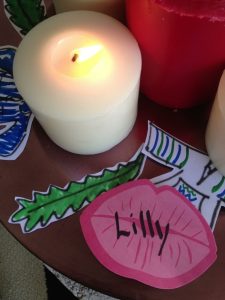
Day 5: Thursday: THE LAST SUPPER (Pieces of Cloth and placemat)
Light all the Candles and have someone extinguish 4 candles.
Pick one of these passages to read: Mark 14:12-26, John 13: 1-17 , Luke 22: 7-30, Matthew 26: 26-30, Luke 22: 14-21
Add a piece of purple cloth under the candles to form a cross. Have extra pieces of purple cloth, enough for each person in your group (cloth pieces should be about 3×6 inches w cut in the the narrow side). You will use these on Good Friday.
Placemat Print Out: Have a paper placemat for each person or have people create one before you begin.
READ the Passage: Imagine the scene. Picture the colors, the smells, the atmosphere of the room.
Consider that it was Jesus’s last meal with his disciples, his closest friends. If it was your last meal what would you be eating and who would be at your table?
Take time to write out or draw your menu for your last supper and name the people at your table on your placemat. Take time to Pray for the friends you have listed. 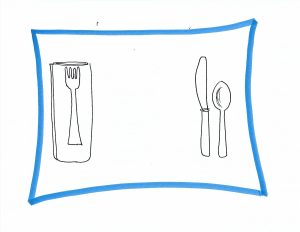
Day 6: Friday GOOD FRIDAY (pieces of cloth) Light only the red candle. Pass around pieces of purple cloth.
Read the story: Matthew 27: 32-54, Luke 23: 26-49, Mark15:21-33, 33-40
Extinguish the candle. SAY “IT IS FINISHED.”
After listening to the passage (use Bible Gateway App to listen to it if you don’t want to read it out loud) have everyone rip their pieces of purple cloth in half symbolic of the temple curtain being torn separating the holy of holies when Jesus died on the cross.
When the candle has had time to cool, have someone cover the centerpiece with a cloth symbolic of Jesus’ burial.
The curtain was ripped top to bottom! We now have direct relationship with God! Talk to Jesus about this.
How does it feel to know that you are not separated from God even in death?
How does it feel to know that Jesus knows and understands your suffering and pain?
What things do you need Jesus to finish for you in your life?
Talk to Jesus about this and share with someone else today.
Day 7: Saturday: (BAND AIDS) All the candles are out. The strips of cloth are on the plate. Entire centerpiece is dark and covered with “burial cloth”
Jesus’s disciples, his friends, have abandoned him and are hiding and afraid. His body is buried in a borrowed tomb.
How are you feeling today about the death of Jesus? What if you didn’t know that Sunday was going to mean resurrection?
Talk about this.
PASS OUT BAND AIDS
Take time to pray for anyone you know who is suffering or sick or feeling afraid.
We have all lost something this crazy season…jobs, freedom of movement, security. Talk to God about this.
Pray also for friends who have suffered a loss or lost a loved one in recent months.
Place a band aid on your wrist as a reminder to pray these people in the next few days.
We are all experiencing grief and loss in this crazy time. Take time to journal or talk about this with someone. What is the grief you feel today? Give this to Jesus to carry for you.
Day 8: EASTER!!!!! (small candles like birthday candles )
You can do this at breakfast or around another meal on your own or with housemates.
If you covered your centerpiece, uncover and RELIGHT ALL THE CANDLES!
Have all the candles lit before people sit down for the meal.
READ the Resurrection Story together! Choose one Matt.28:1-10, Mark 16:1-18, Luke 24
Pass around the birthday or other small candles.
Light your candle from the centerpiece as a symbol of Jesus resurrection and the Light returning to the World. Now we can share that Light and his love with everyone we meet.
Say together: CHRIST IS RISEN! HE IS RISEN INDEED.
What are some ways you’ve seen or experienced resurrection and new life this week?
Spend some time thanking Jesus for his love for you and all the good things that are in your world.
Pray for places that need the Light and Resurrection of Jesus today.
Hospitals, Places of conflict and poverty, medical workers and others on the frontlines.
Pray for your community, your neighborhood, to see and experience more of the love of Jesus.
Pray for specific needs you know about.
Pick a country to pray for in the coming days. Pray that healing love and light of Jesus will be seen there.
Use a map of the world, globe or map on line to pray with this week as we ask Jesus to shine his light and love in these places.
EXTRA: you can create a prayer collage (cutting out pics or words from magazines or drawing them) to remind you to pray for things in your world that need resurrection.
PRAY:
Jesus help us to see your light and experience your resurrection today and every day. Thank you that we are Resurrection People able to share your love and life with others. AMEN
©lillylewin and freerangeworship.com
For more resources check out:
Lilly Lewin @lillylewin on Instagram, Twitter, Facebook, freerangeworship.com and email.
posts and photos by June Friesen,
During the past year many of us have struggled with numerous issues. For some there has been illness of many kinds and some in particular have faced the disease of Covid in their family. For some there has been death of a loved one or loved ones and at times there was not even the opportunity to be with family/friends during these times. Isolation, whether chosen or commanded by others, has left many disheartened and maybe even somewhat disillusioned with life or about life. In the midst of all of these life changes and what we may refer to as abnormalities I want to reassure each one of us that God has not disappeared, He is not ignoring us, nor has He abandoned us. Jesus rather invites us to come into His presence, to sit with Him and let Him guide us through this time.
Matthew 11:27-30 (The Message)
27 Jesus resumed talking to the people, but now tenderly. “The Father has given me all these things to do and say. This is a unique Father-Son operation, coming out of Father and Son intimacies and knowledge. No one knows the Son the way the Father does, nor the Father the way the Son does. But I’m not keeping it to myself; I’m ready to go over it line by line with anyone willing to listen. 28-30 “Are you tired? Worn out? Burned out on religion? Come to me. Get away with me and you’ll recover your life. I’ll show you how to take a real rest. Walk with me and work with me—watch how I do it. Learn the unforced rhythms of grace. I won’t lay anything heavy or ill-fitting on you. Keep company with me and you’ll learn to live freely and lightly.”
As I look upon this picture of Jesus and read this passage of Scripture there are a couple of things that catch my attention and I also find comfort in them for my spirit. I notice the countenance on Jesus face here and while it seems sad to me it holds an invitation which says, “Come to me my dear one, sit with me here at this table, and embrace my presence. I understand that there is a struggle ahead for Me as well as you; let us walk through this struggle together.”
The second thing that I notice is that Jesus eyes seemed focused upward towards the heavens where His Father awaits as He completes the full reason for His life here on earth. For me this is a reminder as well as an encouragement to also focus upon God as my Father who will help me complete my purpose here on earth.
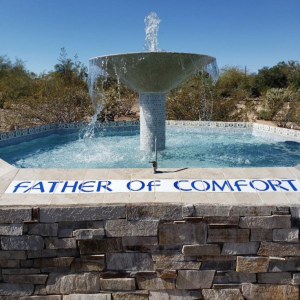
photo by June Friesen
Focusing On God
“Come to me” I hear spoken to me in a whisper,
Yes, it is quiet –
But oh, how peaceful it comes –
I just want to stop – I just want to be – I just want to rest –
And so, I do.
As I pause, I listen….
I hear the refreshing sound of water
And I am reminded that water brings refreshment,
Water brings cleansing and also healing,
Water – a sign of birth physically as well as spiritually.
“God, today as I sit with You,
I feel somewhat abandoned and alone,
Sadness, brokenness, disappointment, struggle…
Is this really what my life is now to hold –
Or is there…somewhere…somehow….an answer to this all?
Ahhhhh….just sitting with You……
Just leaning into Your presence…..
Feeling the spray of water droplets upon my being…..
Ahhhhhhh…………breathing quietly…..
I now arise….and walk forward into a new beginning. Amen”
(June Friesen 3/2021)
The picture we began with today symbolizes the Last Supper as Jesus prepared for His final work here on earth. It is His final work that culminated with His resurrection where God achieved victory over the physical death of sin, a gift God offers to humanity.
Today, may I suggest a moment of quiet pause and refreshment: 1) Get a glass of fresh cold water; 2) sit in a favorite quiet space (indoors or outdoors); 3) read through the final prayer slowly, stopping to take the occasional sip of water….. Rise and go into your day refreshed. Amen.
I was reading a book called ‘Celtic Christianity’ some years ago when I found the most beautiful translation, by James McKay, of an ancient 5th Century prayer attributed to St Patrick. In it the saint asks for God’s protection, and we know it today as ‘St Patrick’s Breastplate’.
Now the cynics among us might want to quip, “Well God doesn’t seem to be doing a very good job at the moment, protecting us, does he!” But we might argue, “Isn’t it far better to be wrapped in God’s safe arms and loving care, rather than to wander through life aimless and lost and frightened? It’s a comfort to know that living or dying, we are his regardless, now and through eternity!”
My call to ministry initially came while singing a hymn based upon St Patrick’s breastplate, called ‘I Bind Unto Myself today’. So this particular piece of writing is very special to me, so much so that I wanted to put my own music to it.
(Words translated by James P Mackay from the book, ‘An Introduction to Celtic Christianity by T&T Clark Ltd) Music © 1995 Sheila Hamil), used with permission.
Gift of Wonder, Breath, and Celtic prayer cards are all on sale for St. Patrick’s Day!
Today is the last day to take advantage of the sale!
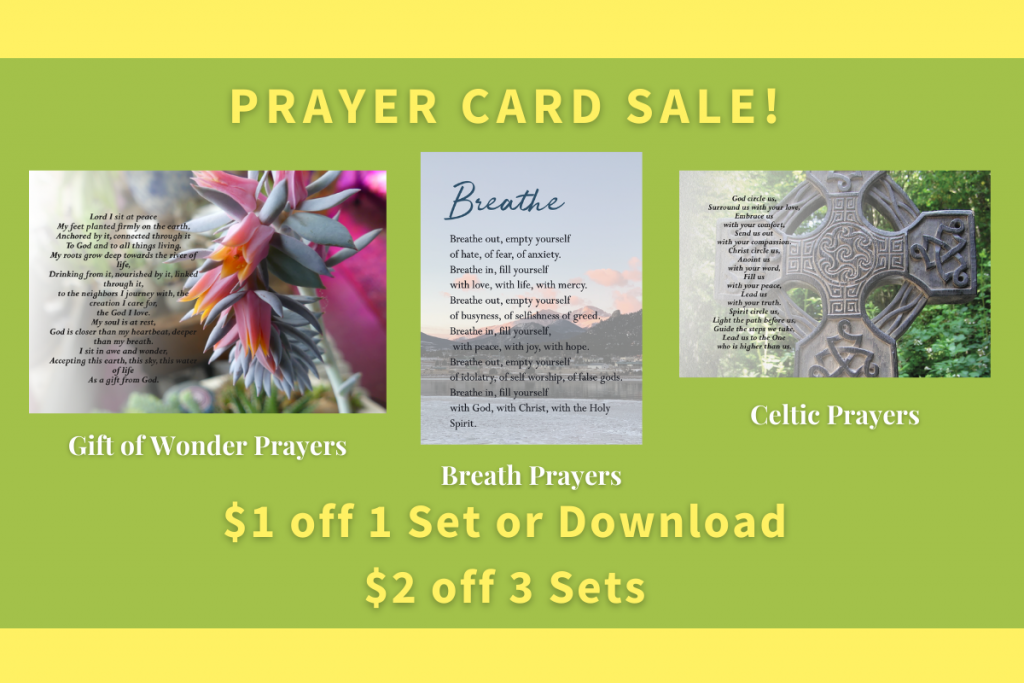
by Carol Dixon, photos by Carol Dixon unless specified,
People these days often refer to trees as the lungs of the planet but I wonder if they realise how they can heal human beings too.
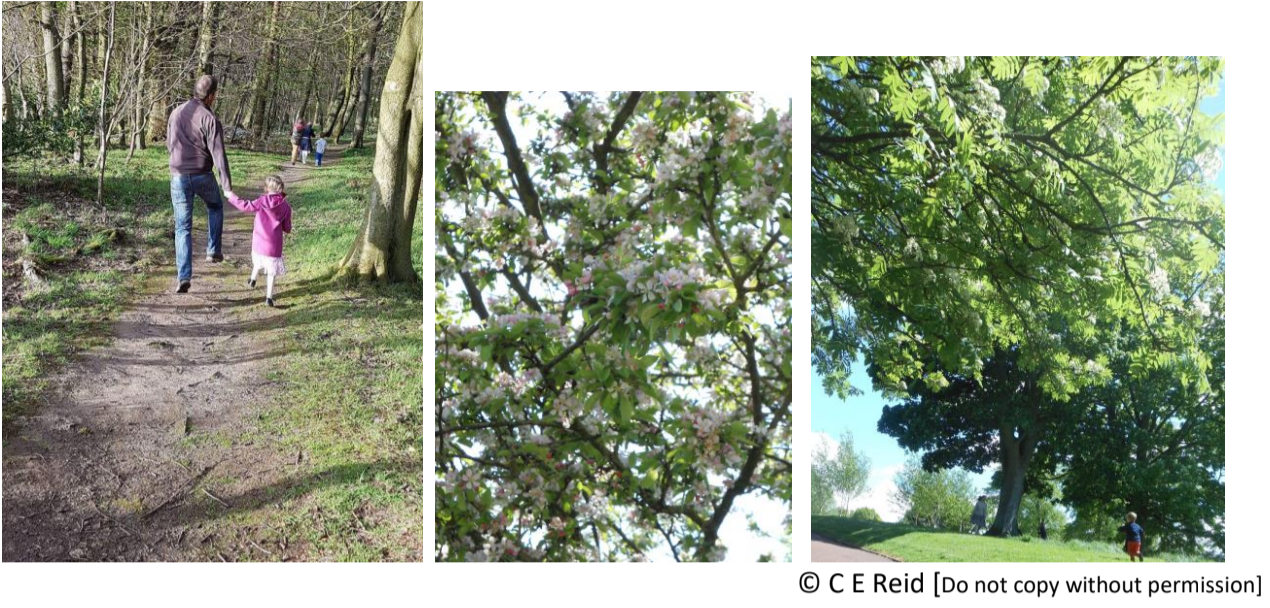
When I was young, I spent a lot of my time in woods near my home. Sometimes I was with friends as we climbed trees, made dens, swung on homemade swings hung from branches, or played hide and seek. At either times I would go on my own and search for acorns, look at the intricate patterns on different leaves, feel the bark on the tree trunks, or my favourite pastime of all – lying on the grass looking up at the sky through the tree canopy, seeing the sun dancing through the leaves and listening to the birds singing. Even now as an adult walking through woodland, I love listening to the rustle of the leaves and the murmuring of the breeze in the branches, as though the trees were whispering to each other – and I enjoy sharing these magical moments with my grandchildren.
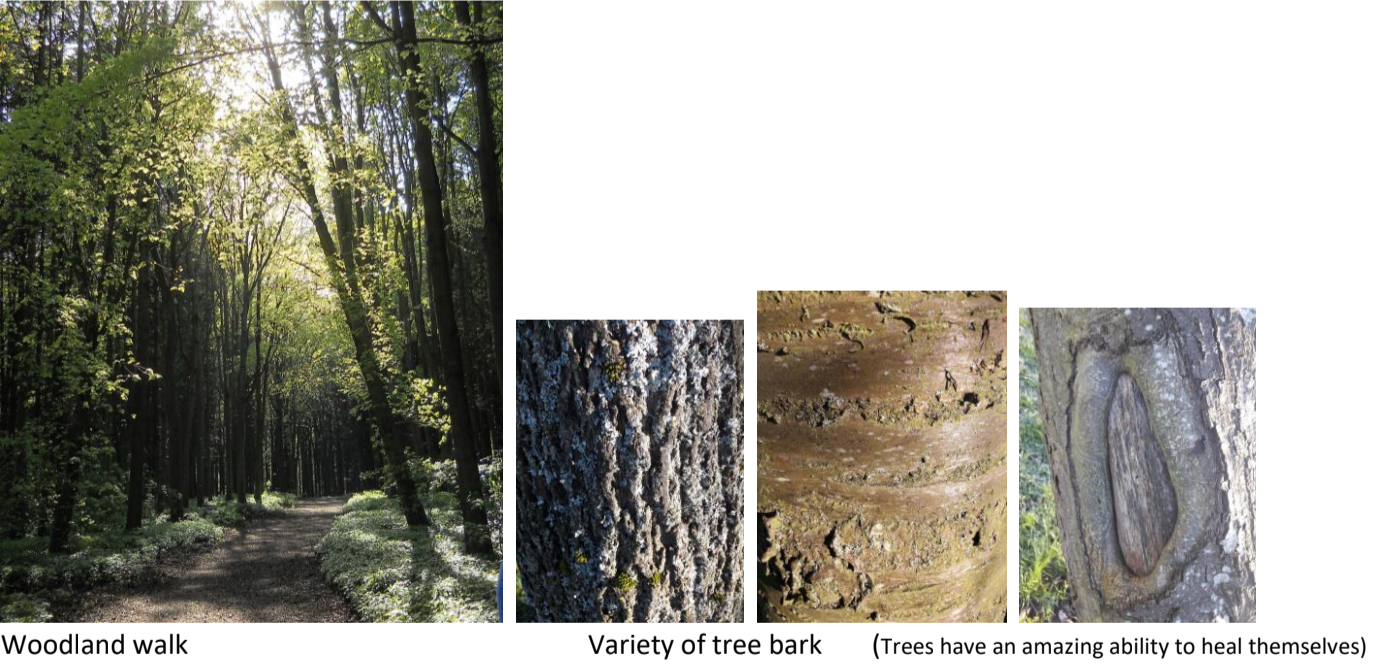
I didn’t know it then but when I wandered through the trees soaking up the variety and beauty of the woods, I was ‘forest bathing’, an activity that has become very popular in the UK in the past few years and has been advocated for health & healing. For those who haven’t come across it before, it is a way of submerging yourself in nature to promote mindfulness and well-being. The Japanese practice of – literally, forest bath – is reputed to have the power to counter illnesses. It is an opportunity for people to take time out, slow down and connect with nature. Although people have been taking walks in forests for centuries, new studies believe that such activity may reduce blood pressure, improve concentration & memory and aid sleep, and a chemical released by trees and plants, called phytoncides, was found to boost the immune system.
An advocate of the practice states ‘We are designed to be connected to the natural world, to “listen to the wind and taste the air”. When you embark on forest bathing make sure you have left your phone and camera behind. You are going to be walking aimlessly and slowly. You don’t need any devices. Let your body be your guide. Listen to where it wants to take you. Follow your nose. And take your time. It doesn’t matter if you don’t get anywhere. You are not going anywhere. You are savouring the sounds, smells and sights of nature and letting the forest in. People initially think they’ve been doing this all their lives: going for a walk in the woods. But it might be a brisk walk, or you might be worrying about where the dog has got to. A better way to frame forest bathing is mindful time spent under the canopy of trees for health and
well-being purposes.’
Some trees are very special and leave a lasting impact. There have been many special trees in my life: In Alnwick Garden in my home town, is the very old tree I used to visit with my grandmother who told me that she played beside it as a child. (I even wrote a story about it for my grandchildren).
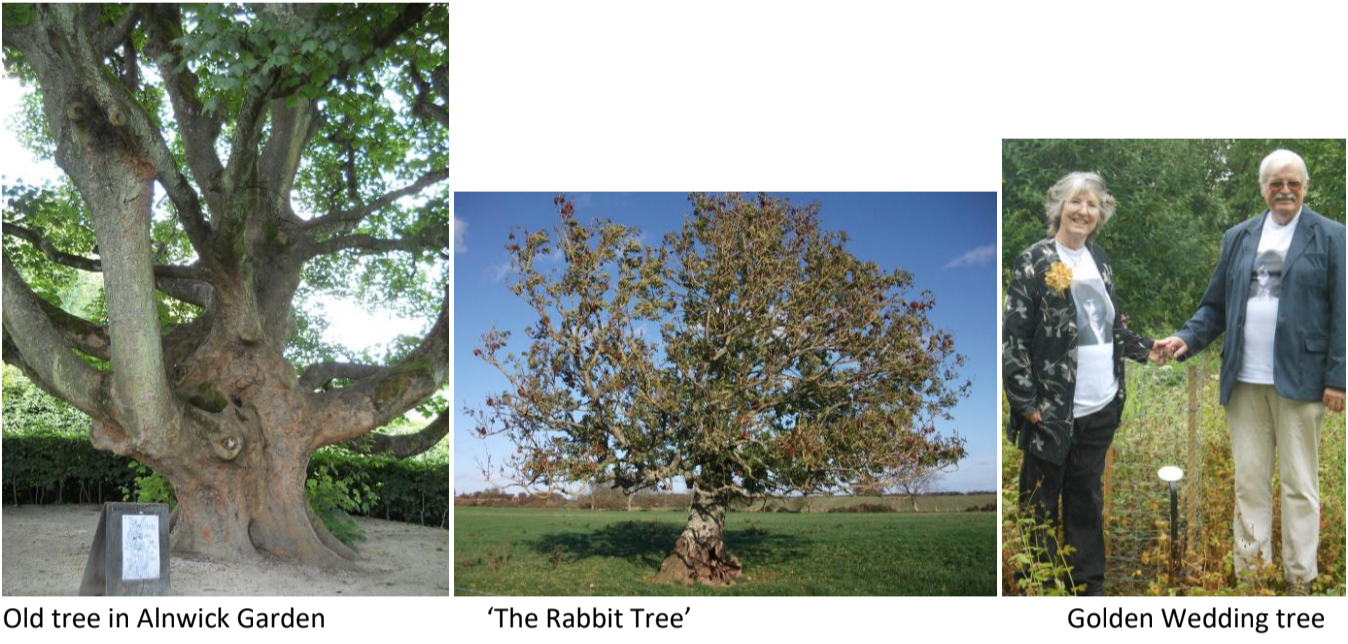
There is also the ancient oak over 400 years old that grows beside the Rock Mill burn on the farm where my husband grew up, the copper beech he planted as a small child with his mother and the Rabbit Tree, an old hollow tree where he and his brothers used to watch the rabbits running up the inside to sit on the branches (I didn’t believe him until I saw it for myself when we were courting!) Last year, we celebrated our Golden Wedding by planting a tree beside the lake nearby where we got engaged over 51 years ago.
Regardless of what season it is there is something to savour. I love the burgeoning buds on the tips of branches in spring, the variety & glorious profusion of trees in full leaf in summer, the myriad colours of autumn trees as you crunch through the fallen leaves looking for conkers and sometimes my favourite of all – the stark beauty of tree silhouettes against the winter sky. The whole life cycle of trees fascinates me. I belong to an ecumenical prayer fellowship called the Companions of Brother Lawrence who try to practice the presence of God in everyday life. One of my favourite stories about him is his conversion which happened through seeing a bare tree in winter blossoming into full bloom in spring. This is how he
described it: “In winter, seeing a tree stripped of its leaves and considering that within a little time the leaves would be renewed and after that the flowers and fruit appear, he received a high view of the Providence and Power of GOD which has never since been defaced from his soul. This view had perfectly set him loose from the world and kindled in him such love that he could not tell whether it had increased in above 40 years that he had lived since.” (from Brother Lawrence, The Practice of the Presence of God)
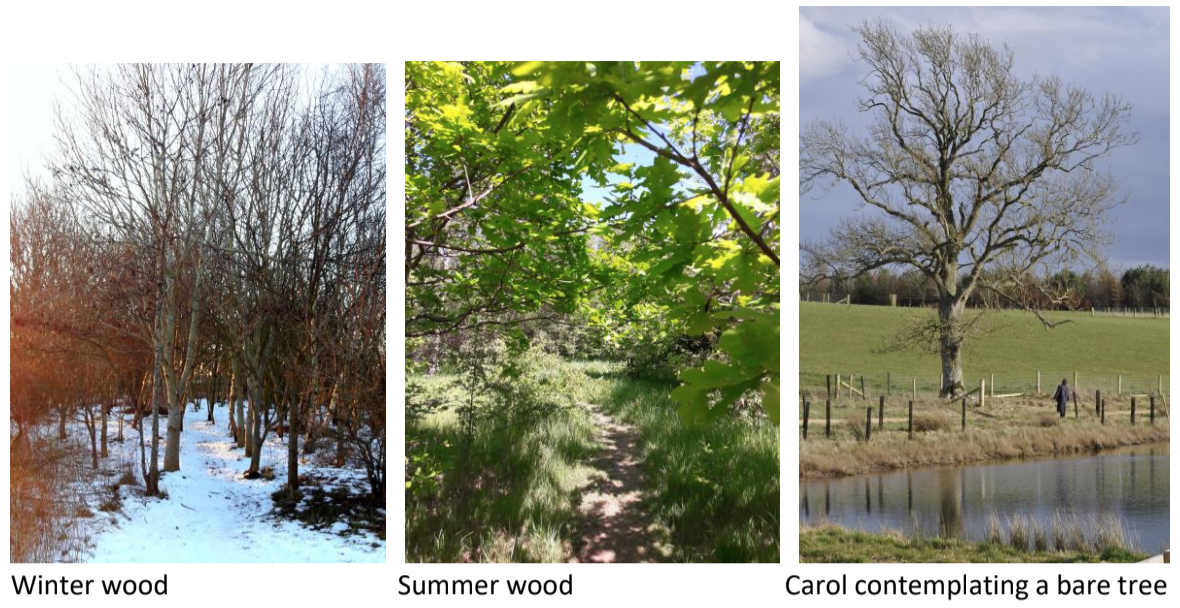
Trees have been important to human beings all through history and are mentioned in the Bible from the very beginning in the Creation story in Genesis where we read of the Tree of life and the forbidden tree of knowledge of good and evil in the Garden of Eden, to the end in the book of Revelation which tells of the tree whose leaves are for the healing of all nations that flows by the river of life. What a beautiful picture that conjures up.
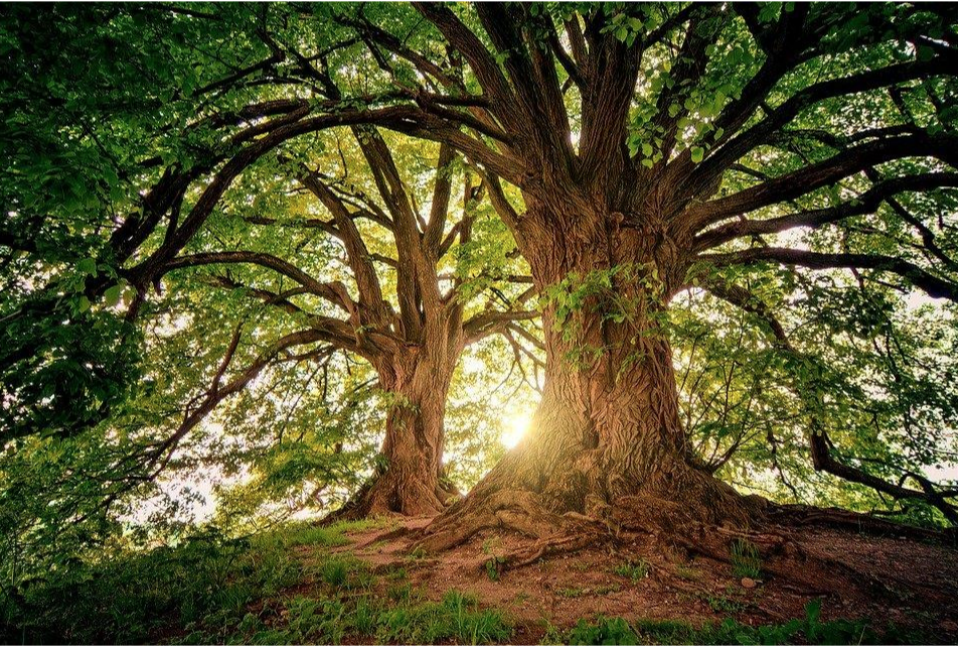
Image by Jplenio (from pixabay, free image)
Some years ago, I wrote a reflection on the wonderful amazing power of a tree from its ‘birth’ from a tiny seed to the great towering giant it becomes over the centuries. It was called Faith in a nutshell – a meditation on a beechnut (Good Ground – Reflection on new growth in old places – Godspacelight). Recently, I have been reflecting on it again – on the mind-blowing thought that from just a small seed such a majestic tree could come. For me, thinking of the tiny seed buried in the earth, battling its way out of the darkness, and the small fragile sapling surviving winter gales to become a strong and sturdy tree is such a hopeful symbol of our lives, strengthened by the Holy Spirit rising from difficulties and despair to new life, healed and restored by God. The woods are even a good place to weep in times of sadness and feel the embrace
of the encircling trees which have stood through many storms over the centuries. As we walk with Jesus through the austerities of Lent, we can look forward to the re-creation of our lives and our world, currently imprisoned by the coronavirus pandemic, finally free to meet and mingle with one another again. Truly an Easter blessing.
The woodland nearest to where I live is relatively new. It was planted about 15 years ago on the site of a former opencast mine by lads from a young offenders’ prison in the area. Each day during lockdown as I walk among these young trees, I rejoice that this former industrial site has blossomed into a place of beauty and I give thanks for those young men, most of whom are now free having served their sentences, whose hard work helped to transform a waste land into something restful and renewing for our village to enjoy.

Image by kretktz (from pixabay, free image)
Birch Copse
Walking from the sombre shadow
of towering trees, the encroaching
curtain of darkness parted,
revealing a slash of light;
a grassy glade, peppered
with forget- me- knots
beckoned; tiptoeing
into the secret space,
I trod tentatively,
as if entering an unfamiliar
holy place, where angels’
feet had brushed the ground,
heard the rustle of wind,
or wings, and found
just what I needed –
a welcome time of rest,
and re- creation.
©Carol Dixon (Published on Places of Poetry website 2019)
It isn’t always possible to walk among the trees and when I am stuck in the house for whatever reason I like to listen to a piece of music called ‘Pachelbel – Forest Garden’ by Robert J. Hemmer and imagine myself taking a walk with Jesus through a wood and I feel so much better afterwards. If you can’t go outside and walk in woodland or talk to a tree you may like to lose yourself in a forest for a few moments as you listen.
(there is a natural break after 8 minutes if you haven’t time to listen to it all)
Gift of Wonder, Breath, and Celtic prayer cards are all on sale as we look forward to St. Patrick’s Day!
Take advantage of this sale now through March 17th.

by Christine Sine
On March 17th, we celebrate St Patrick’s Day, and for me it is a great time to celebrate the many ways in which this stream of Christianity has enriched my life.
One of my favourite places in the world is the island of Iona off the west coast of Scotland. It seems so remote now, requiring a journey from Glasgow by train, ferry, bus and another ferry to get there. At one time, when most long distance travel was done by sea, it was a thriving centre of spirituality and education. It was here in the 6th century that the Celtic saint Columba settled after being exiled from Ireland. And it was also here that the famous Book of Kells was probably written.
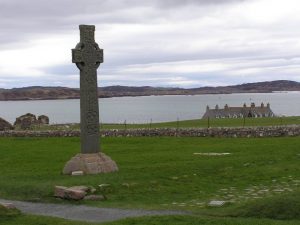
Iona cross with Bishop’s house in distance
My husband, Tom, took me to Iona on our honeymoon 29 years ago, sharing with me not just a place but a Christian tradition that was very special to him. My imagination was ignited by this ancient faith perspective which thrived from the fifth to eighth century and was responsible for the spread of Christianity from Ireland through Scotland, England and much of Western Europe. It offered so much of what I craved—an intense sense of the presence of God, a spirituality that permeated every part of life and a love for creation as a reflection of the character of God. It is possible that St. Francis of Assisi was strongly influenced by the Irish monks who established a chapel near Assisi.
Scottish theologian, Prof John Macquarrie observed that “the Celt was very much a God-intoxicated person whose life was embraced on all sides by the divine Being.” I long for that same intoxication and intimacy with God.
The primary site for worship, pastoral care and religious instruction for Celtic Christians was the monastery not the parish church. This strongly monastic character produced a model of ministry that was communitarian rather than individualistic.
A common misconception is that these early Celtic monks fled to the wilderness and devoted themselves to prayer, fasting and other extreme activities. However, usually, these settlements lay at the crossroads of major travel routes, whether by sea (as in the case of Iona) or land (like Clonmacnoise on the banks of the river Shannon, in Ireland). They were intentional about living the God-filled life at the heart of contemporary culture and business.
These monastic communities were open to a constant stream of visitors, pilgrims and penitents. They were intimately involved in the affairs of the world and the lives of the people they served. The monks were not just concerned with the spiritual wellbeing of the communities they served but also with their intellectual and physical wellbeing. They were also, in many ways, the keepers of culture and tradition, not just copying the Psalms and Gospels but also writing down stories, songs, and poems and preserving myths and legends for posterity.
The Celts approached God with awe, reverence and wonder, but also saw God as an essentially human figure intimately involved in all creation and engaged in a dynamic relationship with it. This interweaving of intimacy and mystery embraced the Trinity as a family, and each human family unit (be it family, clan or tribe) was seen as an icon of the Trinity. The Trinity was a very real presence in all aspects of life and creation, and an almost tangible Comforter and Protector who could ward off evil forces. We see this theological perspective reflected in this simple prayer.
Prayer trail Camano Island
I love the Celtic belief that only a thin veil separates this world from the next. They took seriously Hebrews 12:1 (“Seeing we are compassed about with so great a cloud of witnesses…”), so a Celtic Christian at prayer was consciously a member of the great company that stretched from the persons of the Trinity through the powerful angelic throngs to the risen saints. They were regarded very much as friends and companions in this world and addressed almost as one would neighbours or members of the family.
One of the most demanding and often costly tasks undertaken by the Celtic monasteries was hospitality. Celts believed hospitality was not only meant to be a custom in their homes, but also a key into the kingdom of God. The guest house, or hospitium, often occupied the best site within the monastic community, and though the monks might live on bread and water, visitors would often received the best of food and drink. The monastery at Derry is said to have fed a thousand hungry people each day. Brigit, who presided over the monastery at Kildare, often made butter for visitors. Tradition has it that when churning the butter, Brigit would make thirteen portions—twelve in honour of the apostles and an extra one in honour of Christ, which was reserved for guests and the poor.
One of my favourite Celtic prayers is this beautiful hospitality prayer attributed to Brigid, one of the best-known women leaders of the Celtic church.
Much of our knowledge of Celtic Christianity comes through their beautiful prayers, many of which were written over a thousand years ago, and then gathered in the Carmina Gadelica. The most famous Celtic prayer and another of my favourites, is Patrick’s breastplate, which I adapted a few years ago as a responsive litany. Patrick’s prayer is shot through with a deep sense of the presence of God and a confidence in God’s ability to protect from evil as we see here:
We bind unto ourselves today the strong name of the Trinity,
By invocation of the same, the Three in One, the One in Three.
Of whom all nature hath creation, Eternal God, Spirit, Word;
Praise to the God of our salvation, Salvation is of Christ the Lord.
As this prayer reveals, the presence of Christ was almost physically woven through the lives of the Celts. He encircled, upheld and encompassed them as a companion next to them, a guest in the house, a physical presence in their lives. I love the way that is expressed in yet another of my favourite Celtic prayers:
Christ as a light, illumine and guide us.
Christ as a shield, overshadow and cover us,
Christ be under us, Christ be over us,
Christ be before us, Christ be behind us,
Christ be within us, Christ be without us,
Christ as a light illumine and guide us.
Celtic Christianity opened my eyes to the belief that creation is translucent, allowing us glimpses of the glory of God. The earth and its wonders provide the key not just to establishing the existence of God but also to learning about him. This is no pantheistic worship of the elements but rather a dynamic picture of God’s active presence in creation. God animates and charges all things with divine energy, and they in turn reflect and respond to God’s creative presence and sustaining love. God’s hands don’t simply encircle and protect the earth and all it contains; God also quickens, enlivens and inspires it so God’s existence can be confirmed through contemplation of the beauty and order of the natural world.
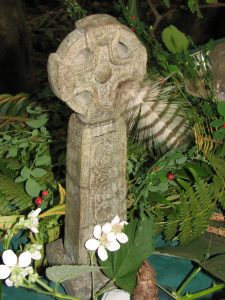
Celtic cross decorating altar retreat 2011
In this tradition, nothing is too trivial to be sanctified by prayer and blessing, whether it be dressing for the day’s work, milking the cow or damping down the fire at night. This sense of the importance of the little things parallels the Celts’ identification with the little people, the marginalized and the oppressed. All persons represented God and might be heavenly visitors in disguise. Extending hospitality opened a door to the kingdom of God and welcomed Jesus into their midst. It was an important expression of love both toward God and neighbour.
My own interest in the sanctity of ordinary, everyday tasks and the importance of finding God within them, and my growing emphasis on the importance of hospitality as a doorway into God’s kingdom is one of the most important practical lessons I have learned from the Celts.
Celtic spirituality continues to enrich my faith, and I often write and use Celtic-style prayers, many of which can be found in the Celtic prayer cards I have created.
There is so much that we can learn from this ancient, future tradition whose followers saw themselves as guests of the world, living lightly on this earth and not becoming attached to possessions or place. They believed all of life was a pilgrimage, a journey towards God in which every experience and every encounter provided opportunity to both represent and learn about God.
Recognizing ourselves as guests and pilgrims affects how we view everything that happens to us. Pilgrims and those who travel frequently do not take anything for granted. They learn to be grateful for comforts that those who never leave home take for granted. For a guest, each meal, especially a home cooked meal, is a gift of love from the host. Each bed provided for us to sleep in is a generous act of sharing and caring. Everything is now a gift of God.
So as you go out into the world this week, think of what you could learn from this ancient tradition. Look for God in the translucence of creation and in the faces of strangers. Think of yourself as a guest of the world and prepare yourself for the amazing gifts God wants to lavish on you today – gifts of friendship, and food, gifts of fellowship and love and caring. And let me know what new things open up for you as a result.
Gift of Wonder, Breath, and Celtic prayer cards are all on sale as we look forward to St. Patrick’s Day!
Take advantage of this sale now through March 17th.

I am really enjoying these Lenten contemplative services from St Andrews Episcopal Church in Seattle. I hope that you are too. And with us celebrating St Patrick’s Day on March 17th, it is so appropriate to have “Christ Be With Me” (Prayer of St. Patrick) – text from the Lorica, or the Prayer of St. Patrick as one of the songs. So beautiful.
A contemplative service with music in the style-of-Taize for the Fourth Sunday in Lent. Carrie Grace Littauer, prayer leader, with music by Kester Limner and Andy Myers.
Permission to podcast/stream the music in this service obtained from One License with license #A-710-756 with additional notes below:
“Nothing But the Blood of Jesus” is a traditional American Spiritual. Solo vocal arrangement by Kester Limner, shared under the Creative Commons License, Attribution (CC-BY).
“Bless the Lord” is a song from the ecumenical Taize community in France. Copyright and all rights reserved by GIA/Les Presses de Taizé.
“Christ Be With Me” (Prayer of St. Patrick) – text from the Lorica, or the Prayer of St. Patrick.
Song by Ruth Cunningham, used with permission. All rights reserved.
www.ruthcunningham.com; www.youtube.com/ruthreid/; Instagram: @ruthreid11
“Lay Me Low” is a musical setting of a Shaker text by organist and composer Daniel Schwandt,
Music That Makes Community, 2013. © 2013, admin Augsburg Fortress.
Thank you for praying with us! www.saintandrewsseattle.org
by Carol Dixon
One of my favourite versions of the Prayer of St Ignatius Loyola is a musical version by my friend, Revd. Sheila Hamil, and includes some beautiful pictures of the Isle of Lindisfarne just off the Northumberland coast where saints of old learned to serve God in ways relevant to their time just as we need to discern what it means to serve God in ours.
[© Sheila Hamil. Used with permission]
Over the past year we have had plenty of opportunity to think about what a life of service means – from the overstretched National Health Service and the individual small acts of kindness in our neighbourhood to the big issues debated in the press regarding the nature of Public Service by our politicians or Service to the Crown as defined by the Royal Family.
A life of service isn’t always easy and motherhood is a good example of this. I was blest with a wonderful mother who always put the family’s demands before her own. Now I wasn’t a natural mother at all, yet through God’s grace I learned to serve the needs of my family without resentment and even with joy. On my own there is no way I could have done this but through God’s grace (and a lot of prayers) God turned me from a selfish person to a serving one as I tried to do what was best for my children. I didn’t always succeed but at least it worked some of the time and my children have turned out to be loving, caring adults who in turn care lovingly for their own kids. In the UK we celebrate Mother’s Day in March and use the opportunity to say thank you to our mothers by giving cards, flowers or small gifts as appreciation of their loving care for us over the years. Two years ago, I was invited to take a service on Mothering Sunday and I came across the following wonderful prayer (© URC Prayer Handbook altd.):
A Mother’s Day Prayer
Creator God, you are our Father and our mother.
We thank you for calling us to be in a relationship with you.
You care for us intimately throughout life.
On this Mothering Sunday
we give thanks for mothers and for your gift of life.
We thank you for the many moments which mothers
played a part in nurturing their children by their faith and service.
Creator God, thank you for the loving gift of mothers.
We thank you for our experience of mothering in our lives:
For women and men who have loved and cared for us,
who have nurtured us and provided for our needs,
who have been there whenever we called out,
and in whom we have placed our trust.
Today we pray for mothers
who are wearied through caring for others,
who are separated from their children,
who are struggling to juggle work and family life,
who are anxious about what the future holds.
L. Loving, mothering God, R. Hear our prayer.
We pray too for women who long to be mothers –
those unable to have children,
and for women for whom motherhood
is a burden rather than a joy.
L. Loving, mothering God, R. Hear our prayer.
We pray for the people who find today a sad or difficult time.
We pray for families who have lost a partner, a parent or a child;
we pray for single parents, for grandparents and extended families.
We pray for families where children or parents have special needs..
and for families where mental illness has led to a loss of memory and recognition.
L. Loving, mothering God, R. Hear our prayer.
We thank you God for families
where children are well happy and full of life.
On this Mothering Sunday, we give thanks for our Mother Church:
for our experience of being loved by a family
that is as wide and broad as the human race.
We give thanks that we can all practise your mothering gifts
as we live and grow in the family of the church.
Here we can learn to be welcoming and comforting,
to share our experiences, to listen to each other,
and to grow in grace and love.
Creator God, on this Mothering Sunday
we give you thanks for the gift of caring
which you have bestowed on us all
through the example of the love and sacrifice
of Jesus, our Servant king. Amen.
During lockdown while we have been permitted only to go out once a day in our local area for exercise, essential shopping or medical appointments, my escape in the dark evenings has been re-watching the BBC TV series Merlin which was first screened about 12 years ago. Like the Harry Potter stories it picks up on the great themes of life: good versus evil, and love & loyalty versus hatred & betrayal. The main character, the teenage Merlin has great powers of magic which happens to be banned in the kingdom on pain of death so he doesn’t know why he has been born with this gift or what he should do with it. By chance he becomes the servant of Prince Arthur who at the time is an arrogant prat – not the great and honourable king of legend that he is to become. These two young lads rub along together in a most amusing manner as they try to discover what they are truly meant to be, with Merlin secretly saving Arthur’s life on many occasions through the use of his hidden power, while all the time doing the most menial tasks and acting as the butt of Arthur & the knights’ jokes. It is only at the end, when Arthur becomes the great king he was intended to be and saves the kingdom with the help of Merlin’s abilities that he realises just how powerful Merlin is and how much he owes to him. ‘Why are you still acting like a servant?’ He asks Merlin as he lies dying ‘When you have all this power’. ‘It’s what I was born for’, Merlin replies. ‘ Your destiny was to be a great king and save the kingdom. My destiny is and always has been to serve you.’
As Christians we are called to serve our great king, Jesus, who knelt before his disciples and washed their feet as a symbol of true servanthood and gave his life for each of us so that we might fulfil our destiny to become the children of God. Through the Holy Spirit we are empowered to help bring about the kingdom of God on earth in the here and now by living lives of loving service, following the example of our Lord and Saviour who banished the darkness of sin and separation through the light of his sacrificial love.
Gift of Wonder, Breath, and Celtic prayer cards are all on sale as we look forward to St. Patrick’s Day next week!
Take advantage of this sale now through March 17th.
As an Amazon Associate, I receive a small amount for purchases made through appropriate links.
Thank you for supporting Godspace in this way.
When referencing or quoting Godspace Light, please be sure to include the Author (Christine Sine unless otherwise noted), the Title of the article or resource, the Source link where appropriate, and ©Godspacelight.com. Thank you!

